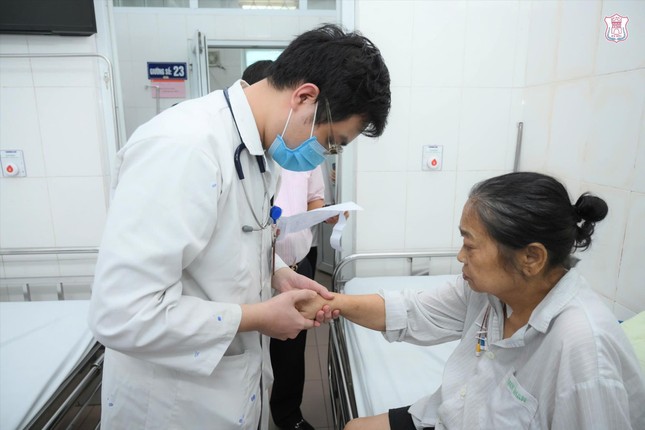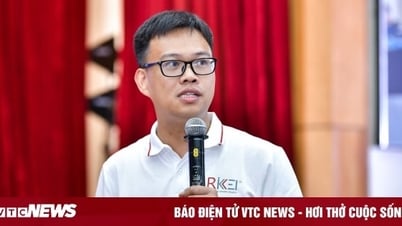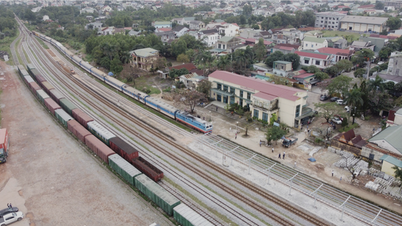 |
| Students of Hanoi Medical University practice clinical practice at the hospital. Photo: HUU LINH |
Prof. Dr. Tran Diep Tuan, Chairman of the University Council, Ho Chi Minh City University of Medicine and Pharmacy, shared that he was once informed by a colleague of the school that in a hospital ward with 18 patients, there were 82 interns. In reality, many schools "release" medical students to the hospital for clinical practice, without a guide, so they are helpless. The obvious consequence is that students do not have clinical knowledge and skills. Graduates lack medical knowledge, weak practical skills, and become a danger to patients when they practice their profession.
According to Professor Tran Diep Tuan, the reason for this situation is that hospitals do not comply with the regulations in Decree 111 (2017) of the Government on organizing practical training in health sector training. The Decree stipulates that this practice facility must ensure: It can only be a practice facility of no more than 2educational institutions training at university and postgraduate levels and 1 educational institution training at intermediate and college levels. However, currently, hospitals accept interns from many schools at the same time, leading to an overload of students, affecting the quality of training and the quality of patient care.
The lack of coordination in the distribution of students from health training schools to hospitals for internships also contributes to the overload situation. For example, in Ho Chi Minh City, there are about 40 hospitals, the number of medical training schools is not much, but interns are only concentrated in large hospitals. Moreover, allowing hospitals to receive funding when there are students doing internships has led to the current chaotic situation. Hospitals are autonomous and need funding to ensure their operations, which is obvious but also unintentionally puts public schools at a disadvantage compared to non-public schools.
At the workshop to evaluate the implementation of Decree No. 111 recently organized by the Ministry of Health , Deputy Minister Nguyen Tri Thuc said that when he was working at Cho Ray Hospital (HCMC), he saw that the number of interns was large and the number of patients was small. When interns asked questions, they showed discomfort and even shouted. Therefore, the students "hid" in the hall to read books and went home after practice time. Thus, students who came to the hospital to practice had roll call but did not perform clinical requirements at the bedside.
Deputy Minister Nguyen Tri Thuc said that some analyses by the Institute of Health Strategy and Policy (Ministry of Health) showed that there was laxity in practical training; there was a situation of laxity, students could go wherever they wanted, do whatever they wanted. Some schools did not have accompanying lecturers, leaving everything to the hospital doctors. Meanwhile, doctors are so busy that they even let them pass when grading exams.
Prof. Dr. Tran Diep Tuan, Chairman of the University Council, Ho Chi Minh City University of Medicine and Pharmacy, shared information about a hospital room with 18 patients but 82 interns. In reality, many schools now “release” medical students to hospitals for clinical practice, without any instructors, so they are helpless.
Practice the “glaze” style
Associate Professor, Dr. Tong Minh Son, Institute of Dentistry and Maxillofacial Surgery, Hanoi Medical University, said that the number of students has increased too quickly. In 2018, there were only 12 schools, now there are about 20 training schools. In 2023, the total enrollment of the industry will be about 1,800 students, and in 2024, it will increase by more than 600 students. Meanwhile, the practice facilities have not met the demand, the teaching staff is lacking and not uniform. New training facilities, young teaching staff should have gaps in experience, capacity, and inadequate equipment. The solution proposed by Mr. Son is to control the enrollment plan.
Dr. Pham Thanh Ha, Deputy Director of the Central Hospital of Odonto-Stomatology, affirmed that the industry enrolling about 2,400 students/year is too large. Graduates working at the hospital do not have skills and can only perform simple procedures. Dr. Ha suggested that the Ministry of Health assign training quotas for the Odonto-Stomatology industry based on clinical practice quotas at hospitals to ensure training quality.
A current mistake in school-hospital coordination is to let the two sides negotiate with each other. Prof. Dr. Le Quang Cuong, former Deputy Minister of Health, Vice Chairman of the State Council of Professors, said that this is the country's job. Because hospitals and universities are just like two wheels of a bicycle in the training program, so a mechanism must be put in place so that the two sides can create a common practice program.
He affirmed that the ratio of students/beds must be strictly regulated, not in general as it is now. On the other hand, training medical personnel not only serves central hospitals but also provincial, district and communal hospitals. Therefore, it is necessary to conduct research to propose regulations that training facilities in which areas should practice in those areas and surrounding areas. Mr. Cuong said that doing so is to avoid training in very far away places and then gathering them at central hospitals, "glazing" but not really learning.
With the current widespread practice of accepting interns, hospitals are overloaded, affecting not only the quality of training but also the quality of patient care. In countries, when allowing the opening of training courses in the local health sector, the aim is to provide medical human resources for the region, and organizing practical training needs to be carried out to achieve that goal.
Source: https://tienphong.vn/dao-tao-nganh-y-duoc-benh-vien-qua-tai-sinh-vien-thuc-tap-post1734642.tpo





![[Photo] Prime Minister Pham Minh Chinh and Prime Minister of the Kingdom of Thailand Paetongtarn Shinawatra attend the Vietnam-Thailand Business Forum 2025](https://vphoto.vietnam.vn/thumb/1200x675/vietnam/resource/IMAGE/2025/5/16/1cdfce54d25c48a68ae6fb9204f2171a)




![[Video] From the 2026-2027 school year, it is expected that enrollment at all levels will be abolished according to administrative boundaries.](https://vphoto.vietnam.vn/thumb/402x226/vietnam/resource/IMAGE/2025/5/17/980466fb5089407da917f9345284639b)

















![[Photo] President Luong Cuong receives Prime Minister of the Kingdom of Thailand Paetongtarn Shinawatra](https://vphoto.vietnam.vn/thumb/1200x675/vietnam/resource/IMAGE/2025/5/16/52c73b27198a4e12bd6a903d1c218846)






























































Comment (0)